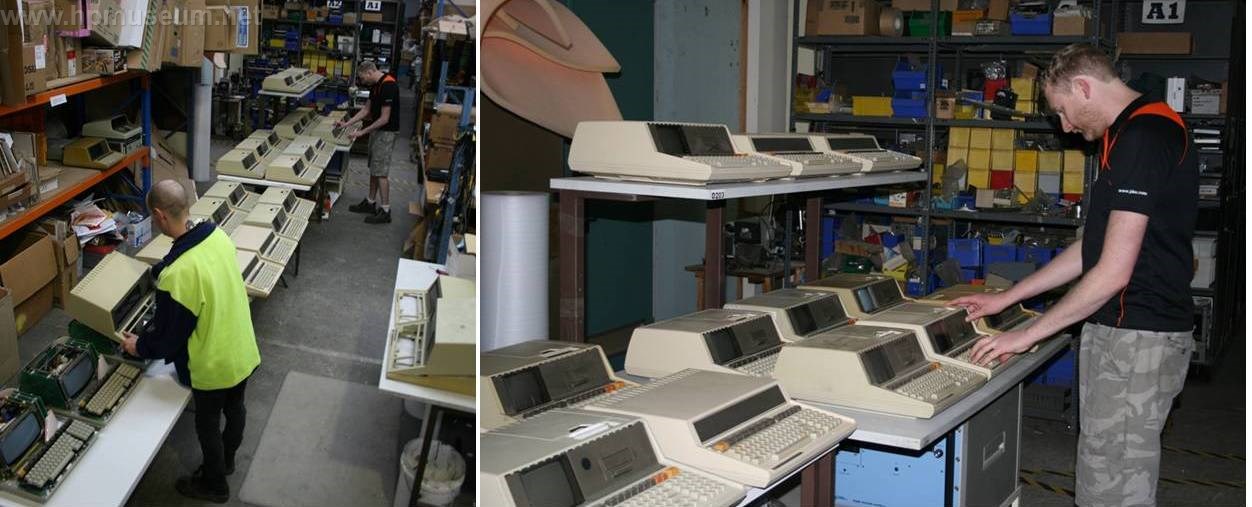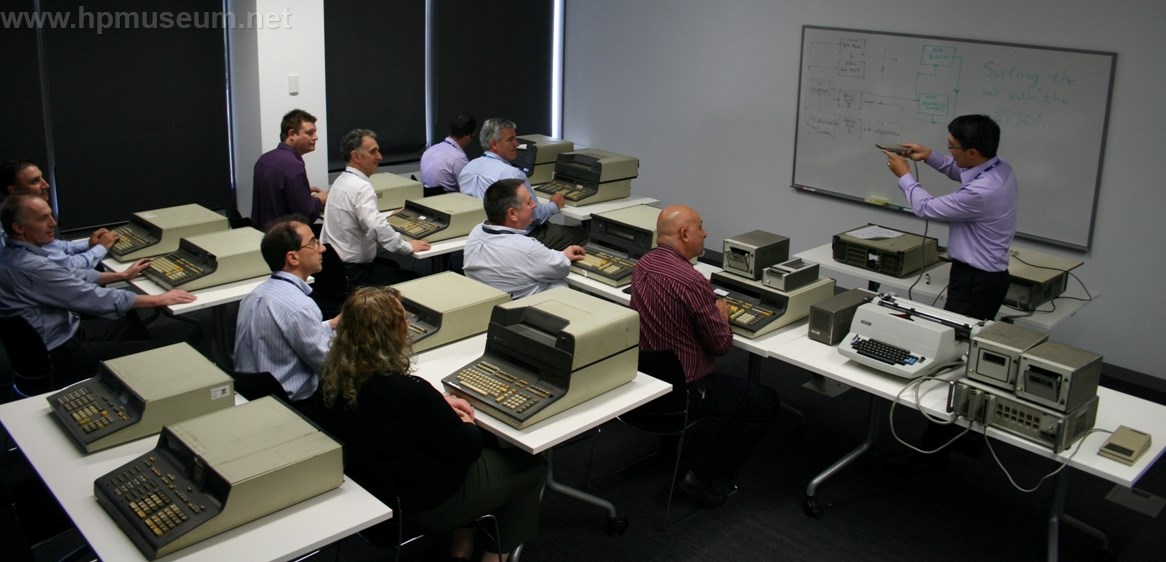Museum Services
PLEASE NOTE: The HP Computer Museum no longer offers the servies described below. This page has been left intact following the passing of the Museum's founder Jon Johnston who worked to set up these services prior to 2016. The information is left as a record of the work Jon did in promoting HP's heritage in computing.
Product Repairs
This service has only recently been introduced by the museum. Prior to 2013, we had never come across an HP computer product that had ever failed (other than RuggedWriter printers, of course). HP’s legendary design and manufacturing quality seemed to keep the old machines humming along as good as new. The only repair work we ever performed was on computers and peripherals that had been dropped, flooded or the victim of lightning strike. Even for the flooded units, it was usually just a matter of drying the machine out and applying some baby powder.
In 2013, we started seeing a few old HP computers with failing board components. Metalized paper capacitors in power input filters are a good example. Some of these have failed after only 40 or 45 years in service. Apparently, HP manufacturing engineers took a few more shortcuts than we had originally thought. Fortunately, the capacitors are easy to replace.
We also started to see the more challenging problem of custom IC failure. With no replacement components available for sourcing, we have had to redesign the original circuit using modern components. As of September 2015, we have completed circuit redesign on about eighty percent of the PCB assemblies used in HP computers between 1967 and 1988. The redesigned boards are more reliable and much faster than the original boards, but they do compromise the “originalness” of the mainframe. The redesigned PCBs can also be expensive to make, with some boards costing up to $40.
The repair service probably won’t be “full service” until the end of the year. While the desktop machines are fairly straight forward (going back to the 9100), the 3000 computers from the 1970s are more of a challenge. By modern standards, very few of these computers were manufactured, and there is not a lot of commonality among components between models. As a result, much of the repair work consists of original circuit redesign. Since these computers often have 30 or more boards, it can take up to a week to redesign, assemble and fully test the new PCBs.
Turnaround time on the desktop computers (9100, 98XX, Series 80, 200, 300, etc) is much quicker, rarely more than a day or two, depending mostly on whether there are any good football games on TV at the time. Because we are still newly into our learning curves, prices are still high, usually between $100 and $200 per unit. For quantity repairs of 50 units or more, we may need up to a week to complete the entire job.

Ken is one of our young engineers who specializes in 9100 repairs.
Volume Manufacturing
Many users of our web site have been reminded of how simple and reliable computing was in the proprietary days. No mysterious system hangs, no blue screens and no computers getting tired over time and slowing down even though they are not living entities. To reduce the support costs and headaches of modern systems, many of our “customers” have replaced their modern systems with the more reliable classic systems. These companies have purchased vintage HP computers on eBay and other markets to run their data acquisition, industrial and scientific applications. Business and financial applications do not appear to be part of this trend; we are only aware of a few dozen companies who have migrated these types of applications.
But, buying old computers individually is a big hassle and takes a lot of time, especially when an organization needs to acquire a few hundred machines or more. As a result, we have introduced our volume original manufacturing program (VOMP). The museum now provides volume original manufacturing for HP 1000/2000 computers (including 21XX), as well as technical workstations from the 1970s and 1980s (98XX, Series 80, 200, 500 and 300). For Series 300 computers, we do not offer the full range of what HP originally provided, and most of the models come in the 9000/320 form factor. For the other desktops, our VOMP provides exact duplicates of the original HP products.
Most products made by HP before 1980 had some assemblies which used components that are no longer available. We have done circuit redesign for these assemblies using modern components. The redesigned assemblies are guaranteed to be 100% compatible with the assemblies they replace, and are generally much faster. Approximately 20% of the VOMP assemblies used in the desktop computers are redesigns, with the other 80% being exact duplicates of the original assemblies. Interestingly, only about 10% of the assemblies in the older 1000/2000 computers are redesigns.
The museum does not have any plans to provide volume manufacturing for 400 Series computers. Since these computers are so similar to the 300 Series in functionality, we recommend that range instead (so stop complaining). We are, however working on providing VOMP for the 700 Series desktops, in response to overwhelming demand. We still have a fair amount of work to do to complete the tooling for the PCBs as well as for the mechanical parts. It is unlikely that the program will be ready for the 700 Series before the end of the year. Second hand 700 Series computers are still fairly common, so just hang on a little longer.
While our pricing is still high, it has come down dramatically over the last six months as demand has soared. All pricing is done by custom quote. For planning purposes, prices are approximately 50% of the product’s original retail price for orders of ten units or less. Prices are reduced by ten percent for each doubling of the order quantity. No credit application is required and payment terms are net 90 days. We only build to order and do not stock components for manufacturing. Some products use components that have long ordering lead times. As a result, it can take us up to two weeks to complete orders of 100 units or more.

Rhys completes final chasis assembly on a small 80 Series run while Mark performs final testing.
Education Services
Even in the beginning, HP products were very easy to use. Most customers plugged them in, turned them on and starting using the machines right away. It was all very intuitive. While there was little pre-packaged software at the time, programs mostly wrote themselves. Occasionally, users needed to refer to a product’s user manual in order to perform particularly arcane tasks. While referencing manuals was very rare, when the need did arise, the manuals usually just opened up to the required page, so users didn’t have to bother with the table of contents or index.
However, many HP computers ended up in organizations which had some “slow learners”. Despite the products’ ease of use, some users needed a little extra help in order to take full advantage of the machines’ capabilities. So, HP offered a variety of courses on using and maintaining its computers. Since the museum has the materials for all of these courses, we have decided to offer the same instruction as was originally provided directly by HP.
Our courses are run on all weekdays except public holidays. Each of our courses runs for a full day. For students who might require additional training, we recommend considering a new career instead; and we provide a free listing of open government positions in their area. For the first week of each month, we offer a fixed curriculum as identified below:
First Monday – HP 2000 timeshare systems and 21MX computers
First Tuesday – Early Workstations 9100, 9810 9820 and surfing the web with the 9830.
First Tuesday – Original 3000 systems running MPE and PA-RISC systems running MPEiX
First Wednesday – 200 and 300 Series including weather modeling and econometrics
First Thursday – 9845 (full day by itself)
First Friday – 80 Series
We will shortly be adding fixed programs for the 80 Series, 500 Series, 250/260/300 and HP1000/A-Series. Although it is sometimes possible to obtain standing space in one of our fixed courses on the day of the class, we recommend booking a month in advance. We limit each classroom to 50 students (plus standing room). You are welcome to bring your own computers or rent one of ours for the day for $15 (plus the $99 daily course fee, lunch not included).
Our courses do not include exams. We do not test students on the subject matter. Some of our students come just for a day of relaxation or as something new to do on a date (though, none of our students have ever actually had a date to our knowledge).
So, if you are a little slow on the uptake and need some extra time to learn how to use your HP computer, please contact us to enroll in one of our courses.

Phil speaks very slowly while instructing our remedial 9830A class.
| Back |
^ TOP©2004 - 2024 BGImages Australia - All Rights Reserved.
The HP Computer Museum and BGImages Australia are not affiliated with HP Inc. or with Hewlett Packard Enterprise. Hewlett Packard and the HP logo are trademarks of HP Inc and Hewlett Packard Enterprise. This website is intended solely for research and education purposes.
